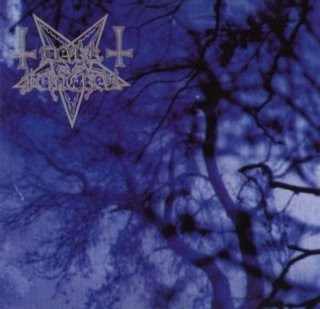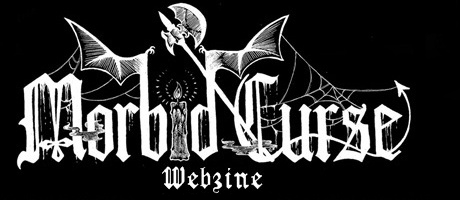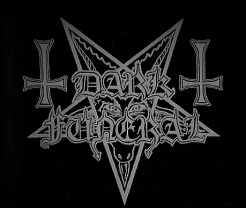
|

|
Dark Funeral (1994)

In the early-to-mid 1990s, countless bands were spawned in the underground, inspired
by the recent popularization of black metal that followed the albums and antics of those in the Norwegian scene. It should
then come as no surprise that musicians in neighboring Sweden would be drawn to this style. Several new projects came into
being, while some extant bands took on a darker approach. So it was in 1993 that Blackmoon, already a veteran of death metal,
created Dark Funeral with a few younger musicians, including Lord Ahriman. By the following year, they entered the doomed
Unisound studio to record that material that would be released in May 1994 as the Dark Funeral E.P.
Unfortunately, this was
during the period when Dan Swanö was butchering black metal albums, either from incompetence or a lack of understanding. Albums
like Those of the Unlight and Opus Nocturne from Marduk, for example, were nearly ruined thanks to the flat
and lifeless sound, and Dark Funeral was no exception. By some miracle, Dissection was able to get the only good
results from this studio, likely taking a more hands on approach than other bands, but they were alone in this. At any rate,
the production is professional and could have been much worse, but that doesn't excuse the muddled, impotent sound that plagued
so many recordings. The guitars are not as high in the mix as they should be and lack any sort of edge, whatsoever. As well,
the drums are a little too clear and loud, for my taste. Nevertheless, knowing Blackmoon, a necro or lo-fi production was
never in the cards anyway, as he preferred things to sound professional and of the highest possible quality. He is quite a
serious musician and is not terribly fond of raw demos and rehearsal tapes. It was likely his experience with Necrophobic
and musical competency that resulted in the well-developed songwriting on this E.P. Each track has its own identity and the
riffs flow naturally, from one to the next. The various tempo changes help to prevent things from becoming dull, as well.
As for
the material itself, there are only four songs on this release, which is too bad as a full-length in this style would have
been interesting to hear. There seems to be a little more variation among the compositions, compared to The Secrets of
the Black Arts, though it may just be that there was less of an opportunity for repetition given the rather short run-time.
One difference might also be that Draugen was a less one-dimensional drummer than Equimanthorn. Regardless, there are more
moments throughout the songs where the riffs are clearly the focus and are allowed space to breathe and actually create a
bit of atmosphere. Some of the riffs bear similarities to Necrophobic, possessing the same nocturnal feeling. That said, the
most obvious comparison, overall, would have to be with Marduk. While the guitarwork and songwriting is quite good, the vocals
are sort of a weak point. Themgoroth seems to be punching above his weight, so to speak, clearly struggling with some of this
material. It is evident that he was having trouble managing his breathing and was doing all he could just to keep up. Even
at his best, he wasn't a particularly good or interesting vocalist. Trying to emulate someone like Af Gravf, without the skill
to do so, was probably a bad idea.
It's strange how Swedish bands could never get away from the 'brighter' melodies, most of the time. Very rarely
did any of them capture the same kind of dark feeling as found on the classic Norwegian albums. With a different production,
some of the guitar riffs would have had a better chance to create a cold feeling, at least, but the flat sound and the annoying
double bass both often hinder any chance of this. The strongest songs are the first two, "Open the Gates" and "Shadows Over
Transylvania" and one cannot help but wonder why the former was not also re-recorded for the full-length, unless it was felt
that they had done it to the best of their abilities or that it would not fit in with the rest of the songs for some reason.
For those
who may not be aware, Dark Funeral was not always worthless rock stars existing only to make money off of stupid merchandise
and watered-down, garbage albums. In the beginning, the guys who came together and created the band in the first place actually
made some decent music. Despite having some flaws, this E.P. is worth a listen and stands as one of the few monuments to a
time when this band wasn't irrelevant. "Open the Gates", itself, is worth picking this up. If you've only heard the later
releases, definitely throw then in the trash bin and listen to Dark Funeral and The Secrets of the Black Arts,
instead.
(3 Feb. 2009)
The Secrets of the Black Arts (1996)

Released in January 1996, The Secrets of the Black Arts is the first full-length
album from the Swedish black metal band, Dark Funeral. It features cover artwork from the well-known and respected Necrolord.
It was originally recorded at Dan Swanö's Hellspawn/Unisound Studios, the same as the self-titled E.P., but Blackmoon was
incredibly dissatisfied with the sound. As somewhat of a perfectionist, he fought hard to not release the first version of
the album. Attempts were made to fix things, but it was deemed to be impossible and so the band traveled up to Peter Tägtgren's
Studio Abyss, where they re-recorded the entire thing. It’s a good thing that they did, as the sound is a vast improvement
over the first take. Since then, the “Abyss sound” has come to mean something overproduced and horribly modern,
but this was not yet the case at the time.
Sad to say, my first encounter with this band was around the release of their second album, which made a bad
impression. In fact, it was so dull that I almost wrote the band off and had no plans to ever listen to anything else of theirs.
However, a little while later, I ran across their debut full-length and noticed Blackmoon (David Parland) on the back cover.
As a fan of his work in Necrophobic, I immediately decided to reconsider and give this band a listen. In some ways, The
Secrets of the Black Arts can be considered as somewhat of a companion piece to Necrophobic’s Darkside
(for which Parland wrote the bulk of the music).
Dark Funeral’s first album is, easily, the best thing that they ever made. Unlike
a lot of the black metal being released at the time, The Secrets of the Black Arts possesses a bit of power and violence.
There’s absolutely nothing fruity or experimental here. While other bands were wimping out and going for a ‘progressive’
approach, these guys were content to just bash the listener over the head with very intense songwriting that is certainly
aided by Tägtgren's production. The highlight, of course, has to be the ice cold guitar riffs. The whole record is filled
with these gloomy, haunting melodies.
It has to be said that, while he certainly poured every bit of energy into his maniacal performance, Themgoroth
can be a bit monotonous and unimaginative at times. That said, he does well enough, sounding like some demonic creature, bursting
with malevolence. As well, while Equimanthorn is clearly skilled, the drumming is a little repetitive and could have benefited
from a little more variation. Some of the songs begin in the exact same way, blast beats and screaming, but it’s worth
fully immersing yourself in the album in order to truly appreciate the dark atmosphere created by such well-crafted riffs.
"My Dark
Desires" and “Shadows Over Transylvania” both first appeared on the Dark Funeral E.P. The newer versions
are likely a little better, just for the fact that the production isn’t as flat and lifeless. The guitars actually have
a little bit of a rough edge to them, unlike the rotten sound that so many bands got from Unisound. (Seriously, it’s
surprising that no one hanged Swanö for spoiling so many albums.)
Songs like “The Dawn No More Rises” and Where Angels Forever Die”
are quite good and probably served as the template for everything the band went on to create after this, but my personal favourites
are “Bloodfrozen” and “Dark are the Paths to the Eternity”. The open-arpeggio riffs of the former
work well in creating a morbid and sombre feeling, hearkening back to classic Mayhem. It’s during those moments when
the drums settle down and the guitars are allowed to breathe that the cold, nocturnal melodies are best able to possess you.
I would say that the final song is the best on the whole album. This is like a hymn to the majesty of the eternal night sky
and blackness so dark that even shadows cease to exist. As the song slows down, there is a clean-spoken part that adds to
the atmosphere being created by this nocturnal ritual. The guitars are cold as ice and the riffs build a sense of tension,
as you are being led toward the great unknown. As the brilliant guitar melodies fade into silence, so too does Dark Funeral's
true potential fade into obscurity.
The Secrets of the Black Arts is one of the most notable releases from any Swedish black metal band.
It launched the career of Dark Funeral and it is on the style and success of this one record that Ahriman (and the various
other members who have come and gone throughout the years) has been able to coast. It’s sad that the band is best known
as a joke, just some irrelevant guys who make worthless albums and tour so that they can sell merchandise to stupid kids that
don’t know any better. But, once upon a time, Dark Funeral had real potential. Back then, Necrophobic-mastermind and
Dark Funeral co-founder, Blackmoon was still the main creative force and the music benefited from this. The band’s rapid
decline after his departure proves this fact. Nevertheless, The Secrets of the Black Arts remains as the one good
L.P. that they ever released and is certainly worth a listen. Fans of early Dissection and Marduk will probably like this.
(22 Feb. 2008)

After the recording of their debut album, The Secrets of the Black Arts, Dark Funeral underwent a complete overhaul. First, Themgoroth was replaced
by Masse Broberg, now known as Emperor Magus Caligula. Equimanthorn was replaced on drums, by Alzazmon (Tomas Asklund). However,
the change that forever crippled the band and left it as merely a shadow of what it once was had to be the departure of Blackmoon.
Once his songwriting genius was removed from the equation, the band stagnated and it was very clear who the driving force
had been. With a new line-up, Lord Ahriman returned to Abyss Studio in the autumn of 1997 and Vobiscum
Satanas was born. It was released by No Fashion in April 1998.
Musically, this is almost a carbon-copy of the
band's debut album. Unable to cope with Blackmoon's absence, it seems that Ahriman did his best to mimic the record that made
Dark Funeral so popular in the first place, to the best of his abilities. And, truth be told, there are plenty of decent riffs
to be found here. The first few songs are somewhat enjoyable, blasting through at an intense pace as cold, nocturnal tremolo
riffs weave in and out. "Ravenna Strigoi Mortii" starts things out on a strong note but, by the middle of the album, the repetitive
nature of the songwriting begins to wear thin. The material is weaker as well, unable to maintain the momentum built early
on.
The production is much clearer than The Secrets of the Black Arts, which
is one of the main differences between the two albums. The sense of rawness that existed on the first album is sacrificed
for increased clarity, though it does not sound horribly overdone. It suits the music well enough, which utilizes a slightly
less violent approach, anyway. The benefit of this is that the guitar riffs are not buried in the mix, as they were on the
previous release, allowing the listener to truly hear all that is going on.
The drumming is still a problem, just like
on the first album. Tomas Asklund continues what Equimanthorn started, with the overactive percussion that creates too much
noise and detracts from the guitar riffs, which should be the primary focus. That said, he has never shown much proficiency
for knowing how to best compliment the melodies, so one would be foolish to expect him to possess such wisdom near the beginning
of his career.
One of the worst aspects of the album has to be the vocal performance. Masse completely altered his
style and sounds nothing like he did on Hypocrisy's first two records, Penetralia and
Osculum Obscenum. Of course, it is natural that he would employ a higher-pitched
sound since he made the move from death metal to black metal, but his entire technique is utterly different in every way.
His voice is very generic and sounds like most other vocalists of the period, almost like a weak imitation of Ihsahn, from
Emperor. He ruins several of the songs by not allowing the music to breathe. Whether it is because he wrote too many lyrics
or just the fact that his vocal patterns attempt to fill as much time as possible, his voice hardly seems to go away for even
a few moments and it takes away from the guitar melodies.
Vobiscum Satanas
is the result of a band that had become a caricature of itself. Had this been Dark Funeral's first album, without the foundation
that was laid by the earlier releases, chances are that the band would not have existed long enough to make a second one.
This record is a failure, epitomizing the words generic and mediocre, and demonstrates that without Blackmoon's creativity,
Dark Funeral was but a pale shadow of what they once were. To hear the true continuation of this band's legacy, pick up Infernal's
self-titled debut, featuring Blackmoon and Themgoroth. As for this atrocity, avoid it and steer clear of the albums that follow.
(11 Oct. 2011)
Return to index
|

|

|





